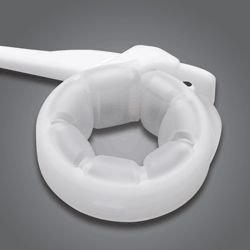Gastric Banding (Lap-Band®)
 The adjustable gastric band, also known by its trade name the Lap-Band, is a permanently implanted medical device that adds restriction to the top of the stomach to reduce the amount of food the patient can eat in one sitting.
The adjustable gastric band, also known by its trade name the Lap-Band, is a permanently implanted medical device that adds restriction to the top of the stomach to reduce the amount of food the patient can eat in one sitting.
The band became very popular because it was not only adjustable but also removable and did not require any alteration of the gastrointestinal system, unlike the stapled procedures we perform. The band became very popular in the early years, second only to the gastric bypass. However, long-term data show that the complication rates that gastric band patients have been experiencing over the long term are significantly higher than those of patients with stapled procedures. Therefore, many bands have been removed over the past several years and revised to other procedures.
The band has become a niche procedure suitable for certain patients, especially those with lower BMIs. Indeed, it is the only procedure approved by the FDA for patients with a BMI as low as 30 with at least one obesity-related comorbidity.
How the Gastric Band Is Performed
Two devices are implanted in the patient: a silicone band and an injection port. The silicone band is placed around the upper part of the stomach and molds the stomach into two connected chambers. The upper, smaller section becomes the primary receptacle for food and makes the patient feel fuller sooner. Food then slowly trickles through the narrowed channel created by the band and is digested normally. The injection port is attached to the abdominal wall, underneath the skin. The port is connected to the band with soft, thin tubing.
The entire procedure is performed in about 45 minutes, and patients can often go home on the same day as surgery.
The video below is an animated illustration of the Gastric Banding procedure:
Adjusting the Band
Band adjustments are made by your healthcare professional using a needle to inject saline solution into the band through the injection port. Adding saline increases the amount of restriction provided by the band, helping patients feel fuller sooner, and with less food. Sometimes saline is removed if the patient is feeling discomfort when eating.
Life After Gastric Banding
Recovery varies between patients, but the less invasive nature of the procedure lends itself to shorter recovery times. Your surgeon will advise you on when to return to normal activity levels, but most patients will feel able to go back to work and a less strenuous activity level after two weeks. Full recovery takes approximately 4-to-6 weeks.
Gastric Banding patients typically lose over 40 percent of their excess body weight, and in most patients, type II diabetes, high blood pressure, and cholesterol will be improved.
Complications associated with the band often require its removal. The band can easily be revised to another procedure such as the gastric sleeve or the gastric bypass in cases of need. Learn more about gastric band removal and revision.
Potential Risks and Concerns of Gastric Banding
- Because of the nature of the procedure, gastric banding can help you feel satisfied sooner, and with less food, but it won’t eliminate the desire to eat. You will have to follow specific diet and exercise guidelines provided by us in order to reach and maintain your weight goals.
- Gastric banding requires more intensive follow-up care than most other bariatric surgeries. Since the band is adjustable, the procedure is a continuous work in progress. Even after reaching your ideal weight, you may need to see us periodically to adjust the band further
- Migration of implant (band erosion, band slippage, port displacement) will require a follow-up procedure to remove or replace the band
- Tubing-related complications (port disconnection, tubing kinking) will require corrective surgery
- Band leak
- Esophageal spasm
- New or worsened Gastroesophageal reflux disease (GERD) is a concern after gastric banding much as it is after a gastric sleeve procedure. Patients who have serious or uncontrolled reflux before surgery might consider the gastric bypass instead
- Inflammation of the esophagus or stomach
- If the band is removed, patients will likely regain all the weight they lost unless they opt for a revisional bariatric procedure
As with any surgical procedure, there are inherent risks including infection, blood loss, and pain. Please speak to your surgeon about these and other risks.
Clinical Data on Band Failure
The laparoscopic adjustable gastric band has fallen out of favor as a result of the significant failure rate that is well documented in clinical data. By reading this study, you can see how the authors reached their conclusion. Of course, through anecdotal and clinical evidence, we believe the same. We encourage you to read more about band failure. However, we also caution against a rush to judgment. While the stats show up to a 44% failure rate, that means that over half of patients with the band may be doing just fine. If you are a gastric band patient and wish to discuss your band, we encourage you to come visit us and discuss further.
